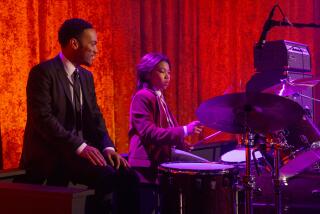Q&A: How one slim novel, 300 soul classics and 3,000 hopeful musicians transformed ‘The Commitments’ into Alan Parker’s most enjoyable film to make

The trailer for “The Commitments.”
In summer 1991, a small movie about a group of young Dubliners who form a band to play American soul music opened with little fanfare. “The Commitments,” directed by Alan Parker and based on the novel by Roddy Doyle, braved the likes of “Terminator 2: Judgement Day” and “Freddy’s Dead: The Final Nightmare” to be a modest success and spawned a hit soundtrack featuring new versions of such classics as “Mustang Sally,” “Chain of Fools” and “In the Midnight Hour.” The album was so successful a second volume was released in 1992.
The first of Doyle’s Barrytown trilogy — “The Snapper’ and “The Van” were also made into movies — “The Commitments” featured a largely unknown cast drawn from Dublin’s thriving music scene that had produced U2 and Sinead O’Connor. Robert Arkins played Jimmy Rabbitte, a streetwise entrepreneur with a dream that a dedicated group of working-class musicians could transcend their dead-end existence through the songs popularized on the Stax-Volt and Atlantic record labels in the 1960s and ’70s.
Parker, previously Academy Award-nominated for directing “Midnight Express” and “Mississippi Burning,” came out of the British advertising industry along with Ridley and Tony Scott, and Hugh Hudson, starting as a copywriter and eventually directing commercials. However, beginning with the Depression-era, all-child cast “Bugsy Malone” through “Fame” and “Evita,” music played a large part in the director’s films.
As “The Commitments” celebrates its 25th anniversary and is released on Blu-ray, Parker reminisced about the making of the film via email from the United Kingdom.
How did you come to direct “The Commitments”?
I was first introduced to Roddy Doyle’s novel (novella? — it was a very slim volume!) by the British screenwriters Dick Clement and Ian La Frenais. We were all living in L.A. at the time and met regularly for lunch. Roddy had written a screenplay of his own and Dick and Ian had been asked to do their version, which they encouraged me to direct. I loved the book when I first read it as it had very little descriptive passages — everything relied on the richness of the dialogue. The book was self published by Roddy, but had become an underground classic among rock ’n’ roll bands. I was a few pages in and found myself laughing out loud. The best kind of humor is when it strikes a chord of truth and Roddy writes with devastating honesty about these working class Dublin Northsiders that he knew so well.
You reportedly auditioned 3,000 musicians. How did that work?
When I arrived in Dublin, we immediately had three days of auditions at the Waterfront Club for 64 bands, one after the other, which the casting directors had culled from pubs and clubs from all over Ireland. In the next weeks, I did my own pub crawl, seemingly seeing every band in Dublin. I then had an “open call” at the Mansion House, town hall, where we saw 1,500 young hopefuls — reading a page of the script and playing an instrument or singing a song.
Many of the eccentric acts in the “audition scene” in the film came from this process, as I tried to show the vast array of disparate, and often crazy, talents on offer.
For instance, Dave Finnegan, who plays Micah the crazed drummer in the film, concluded his manic audition by stuffing the entire microphone into his mouth. I just had to put that in the film.
I had 30 hours of casting tapes in the end, having seen 3,000 hopefuls.
Robert Arkins was originally cast as the band’s singer, Deco. How was Andrew Strong cast?
Robert [Arkins] was one of three that I had narrowed down for the Deco role and was on a short list of two for the manager’s part. Andrew Strong came in very late in the process. I had put 70 songs into rehearsal to see if we could cope with them and various session singers to help. One of them, Rob Strong, pulled out with laryngitis and so sent along his 16-year-old son, Andrew. His voice was extraordinary, and so he nailed the Deco part, allowing Robert Arkins to play the manager.
How did that affect the dynamic of the character?
To be honest, I said to the casting directors, “Find me a kid with the Deco voice and I’ll turn him into an actor.” Andrew fit that perfectly. Also, the script developed organically, and during the rehearsal period we rewrote considerably — swapping and adjusting lines — to fit the actors we’d cast and to better match their abilities and personalities.
See the most-read stories in Entertainment this hour »
Did you always plan to use musicians who could act as opposed to hiring actors who could fake it?
Yes, that was my original plan. I didn’t want to cheat the singing or the music in any way. The vocals were all recorded live to give a more honest and truthful effect and make the drama more believable. Most of the cast hadn’t acted before, but I chose them as much for their strong personalities as their musical abilities. Also, I had extensive music rehearsals allowing us the luxury of dramatic rehearsals too — which is unusual on a film. After five weeks, we could run the whole script through, just like a play.
What was the process for selecting the songs you used in the movie?
I started with tapes of over 300 soul songs and narrowed it down to 70, which I put into rehearsal to see if we could cope with them. Mostly, we had classic soul songs, from Otis Redding to James Brown, and less the Motown songs mentioned in the novel. I suppose in the end I was pretty selfish in my original choices, but through this process, we found what was right for the movie and, more important, right for the cast. It’s always subjective, which songs to include, but we pretty well used everything we did. In the film, there are 68 different music cues including 52 different songs.
The Dublin you depict is very visceral. What things in particular did you connect with?
I probably identified more closely with the working-class kids in Roddy’s novel than the place. I didn’t come from the Dublin Northside, but Islington, North London, where I grew up during the early ’60s, and that was probably the locations I wanted to replicate. Everyone I knew wanted to be in a band, probably, like the kids in Dublin, to escape the world we found ourselves in. However, my skills on the banjo prohibited such ambitions, and so I became a writer.
Roddy Doyle’s novel is set in Kilbarrack, which is a tad suburban, dull even, and not the most cinematically interesting part of Dublin. And so I put together a patchwork of locations, found all over Dublin, to create my own, urban, if mythical, “Barrytown” for the film. Eventually, we shot in 44 different locations over the 53 days of filming.
How much of what we see existed and how much was production design?
Very little of the film was shot in Kilbarrack. So much of what we see was created. The market at the beginning of the film is all production design and doesn’t exist — more an amalgam of different markets across Ireland. As with all films, I usually have a version of my finished film clattering away on a projector inside my head, and it probably differs from Roddy’s book and Dick and Ian’s screenplay. The search for locations is something I very much enjoy by finding an odd, but cinematically interesting building and adapting it to our needs. The snooker hall is a case in point — I could have had a bland rehearsal room, but the rundown billiard hall, formerly a “flea-pit” cinema, was more interesting. The cinematic possibilities of the locations are all part of the organic process, as they become a character in the film. Joey’s house was a similar choice. Frankly, I had to join two locations together divided by a high wall, so I got the girls to climb a ladder to get to their destination and out of that comes a funny scene.
I read somewhere that you said “The Commitments” was the film you most enjoyed making. Do you still feel that way and what made it so?
“The Commitments” was by far and away the most enjoyable film I ever made. When I woke up each morning, I couldn’t wait to get to work. I can’t say that’s been true on all of my films. I suppose it was a combination of the subject matter, the camaraderie of the Anglo/Irish crew, filming the music with a great cast of unknowns — not a movie star in sight. Hence, there were no limos, trailers, egos or tantrums. Every day was filled with music, laughter and joy – and believe me, that’s not normal on any film.
More to Read
Only good movies
Get the Indie Focus newsletter, Mark Olsen's weekly guide to the world of cinema.
You may occasionally receive promotional content from the Los Angeles Times.











